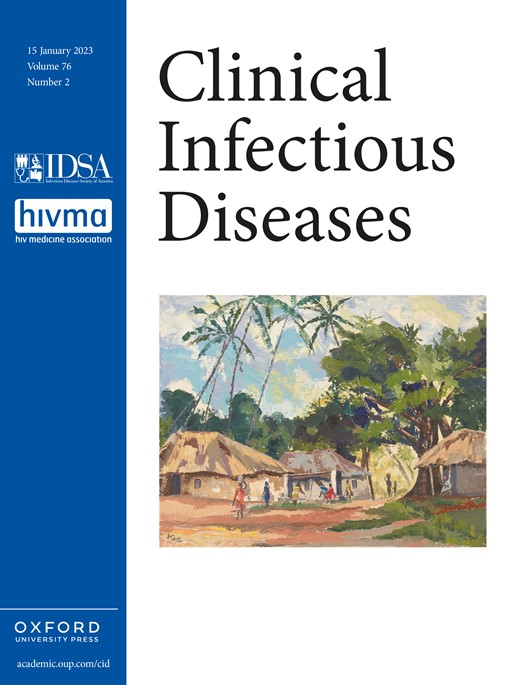
Cover image

Volume 76, Issue 2, 15 January 2023
In the Literature
In the Literature
Major Articles and Commentaries
Twice-Daily Oral Zinc in the Treatment of Patients With Coronavirus Disease 2019: A Randomized Double-Blind Controlled Trial
In this randomized controlled trial, we demonstrated that zinc administered orally to hospitalized patients with COVID-19 could prevent intensive care unit admission and reduce the hospital length of stay. For outpatients, zinc could shorten symptom duration.
A Potential Role for Zinc to Enhance Treatment for Coronavirus Disease 2019 (COVID-19)?
Characterizing the Rise of Disseminated Gonococcal Infections in California, July 2020–July 2021
A total of 149 disseminated gonococcal infection (DGI) cases in California were identified; most were aged ≥40 years, heterosexual, or did not present with urogenital symptoms. All isolates with reported results were susceptible to ceftriaxone and cefixime. Expanding gonorrhea screening may prevent DGI.
Booster Vaccination Against SARS-CoV-2 Induces Potent Immune Responses in People With Human Immunodeficiency Virus
People with human immunodeficiency virus (HIV) on antiretroviral therapy (ART) with good CD4 T-cell counts make effective cross variant immune responses following third dose vaccination against severe acute respiratory syndrome coronavirus 2 (SARS-CoV-2).
Human Immunodeficiency Virus and Cardiac End-Organ Damage in Women: Findings From an Echocardiographic Study Across the United States
Women with human immunodeficiency virus (HIV; WWH) have an approximately 1.7-fold risk of left ventricular (LV) systolic dysfunction compared with women without HIV. Low CD4+ T-cell counts in WWH are associated with isolated LV diastolic dysfunction, LV hypertrophy, left atrial enlargement, and pulmonary hypertension.
Maternal Antibody Response and Transplacental Transfer Following Severe Acute Respiratory Syndrome Coronavirus 2 Infection or Vaccination in Pregnancy
There are higher and longer lasting antibodies in pregnant persons and higher antibody levels in cord blood after COVID-19 vaccination compared with SARS-CoV-2 infection, especially in cases of lower disease severity. Antibody levels wane over time following vaccination and infection.
Transmission of Carbapenem-Resistant Klebsiella pneumoniae in US Hospitals
We characterized clusters of carbapenem-resistant Klebsiella pneumoniae among patients in US hospitals using static and dynamic methodologies of clustering. Widespread intrasystem and intersystem transmission was identified. Use of different methods to assess clustering resulted in only minor differences in interpretation.
Bronchial Washing Using a Thin Versus a Thick Bronchoscope to Diagnose Pulmonary Tuberculosis: A Randomized Trial
This randomized trial compared the diagnostic efficacies of thin and thick bronchoscopes for pulmonary tuberculosis. Bronchial washing using a thin bronchoscope increased the tuberculosis detection rate in patients with pulmonary tuberculosis compared to a conventional, thick bronchoscope.
Association of Treated and Untreated Chronic Hepatitis C With the Incidence of Active Tuberculosis Disease: A Population-Based Cohort Study
In this large-scale, population-based cohort study we found that both treated and untreated hepatitis C are associated with active tuberculosis (TB). People with hepatitis C should be considered for TB-preventive measures, such as treatment for latent TB infection.
Effectiveness of Messenger RNA-1273 Vaccine Booster Against Coronavirus Disease 2019 in Immunocompetent Adults
Among immunocompetent adults, the messenger RNA (mRNA)-1273 booster conferred additional protection against severe acute respiratory syndrome coronavirus 2 infection and severe coronavirus disease 2019 when compared with the 2-dose mRNA-1273 primary series during periods of Delta and Omicron variant predominance.
Co-administration of Oral Cholera Vaccine With Oral Polio Vaccine Among Bangladeshi Young Children: A Randomized Controlled Open Label Trial to Assess Interference
Co-administration of bivalent oral poliovirus vaccine (bOPV) and oral cholera vaccine (OCV) is safe and effective in children aged 1–3 years and can be cost-beneficial. The study results are useful when bOPV and OCV are likely to be co-administered such as integrated OPV and OCV campaign.
Clinical Trial Registration: ClinicalTrials.gov (NCT03581734)
Associations of Immunogenicity and Reactogenicity After Severe Acute Respiratory Syndrome Coronavirus 2 mRNA-1273 Vaccine in the COVE and TeenCOVE Trials
The association between immunogenicity and reactogenicity following 2 injections of mRNA-1273 vaccine was assessed in adolescents and adults (≥12 years). mRNA-1273 elicited high neutralizing antibody titers regardless of reactogenicity. Systemic reactogenicity was significantly related to higher antibody titers post–second injection.
Impact of Enterococcus faecalis Endocarditis Treatment on Risk of Relapse
This retrospective multicentric study of 279 Enterococcus faecalis endocarditis illustrates that relapses are frequent (1-year rate 9.3%) and can occur more than 1 year after the initial episode. Cardiac surgery and antibiotic combination are cornerstones of treatment to prevent relapse.
Effectiveness of Ultraviolet-C Disinfection on Hospital-Onset Gram-Negative Rod Bloodstream Infection: A Nationwide Stepped-Wedge Time-Series Analysis
A multicenter quasi-experimental study with a stepped-wedge intervention design revealed that enhanced terminal room cleaning with ultraviolet-C disinfection was associated with a lower incidence rate of hospital-onset gram-negative rod bloodstream infection at the facility level.
Development of a Human Immunodeficiency Virus Risk Prediction Model Using Electronic Health Record Data From an Academic Health System in the Southern United States
We created machine-learning models to predict incident human immunodeficiency virus (HIV) diagnosis as a marker for pre-exposure prophylaxis (PrEP) candidacy among patients from a southern medical system. The models effectively predicted incident HIV diagnoses and were more effective among women compared to prior models.
Decreased Human Immunodeficiency Virus Diagnosis Rates Among Black and Hispanic or Latino Men Who Have Sex With Men in US Jurisdictions Supported by the THRIVE Demonstration Project, 2014–2019
THRIVE collaboratives were associated with decreasing rates of HIV diagnoses for Black and Hispanic/Latino MSM. THRIVE programmatic activities strengthened prevention services by making PrEP accessible to Black and Hispanic/Latino MSM and supporting utilization of PrEP through navigation and other interventions.
Risk of Psychiatric Disorders, Use of Psychiatric Hospitals, and Receipt of Psychiatric Medication in Patients With Brain Abscess in Denmark
In this nationwide, population-based cohort study, patients with brain abscess and no evidence of prior psychiatric disorders were at no increased risk of psychiatric disorders. However, we did demonstrate an increased receipt of psychiatric medication.
Sex Differences in Subclinical Atherosclerosis and Systemic Immune Activation/Inflammation Among People With Human Immunodeficiency Virus in the United States
Among US persons with HIV (PWH), females demonstrated a lower prevalence of subclinical coronary artery disease (CAD), as well as differences in key immune/inflammatory biomarkers. Understanding sex-specific immune drivers of subclinical CAD will facilitate appropriately tailoring cardiovascular disease–preventive therapies to PWH.
Brief Reports
Japanese Encephalitis Emergence in Australia: The Potential Population at Risk
Treatment of Nontuberculous Mycobacterial (NTM) Pulmonary Infection in the US Bronchiectasis and NTM Registry: Treatment Patterns, Adverse Events, and Adherence to American Thoracic Society/Infectious Disease Society of America Treatment Guidelines
Remdesivir Resistance in Transplant Recipients With Persistent Coronavirus Disease 2019
Viewpoints
Should Linezolid Replace Clindamycin as the Adjunctive Antimicrobial of Choice in Group A Streptococcal Necrotizing Soft Tissue Infection and Toxic Shock Syndrome? A Focused Debate
Observational data suggest adjunctive clindamycin reduces mortality in severe toxin-mediated Group A Streptococcus (GAS) infections, but GAS clindamycin resistance is increasing. Linezolid is a promising alternative adjunct with similar in vitro antitoxin activity but more limited supporting clinical data.
Review Article
Hemophagocytic Lymphohistiocytosis Associated With Cytomegalovirus Infection: 5 Cases and a Systematic Review of the Literature
Hemophagocytic lymphohistiocytosis (HLH) can be triggered by cytomegalovirus (CMV). HLH after CMV infection can occur in immunocompetent patients. CMV infection is nearly always symptomatic, and lung involvement is frequent. Antiviral drugs might be the cornerstone of treatment.
Invited Article
Next-Generation Sequencing Supports Targeted Antibiotic Treatment for Culture Negative Orthopedic Infections
This article describes the gaps in traditional culture and the utility of next-generation sequencing (NGS) in diagnosing and treating peri-prosthetic joint infections. The clinical benefits of NGS compared to culture alone are discussed.





